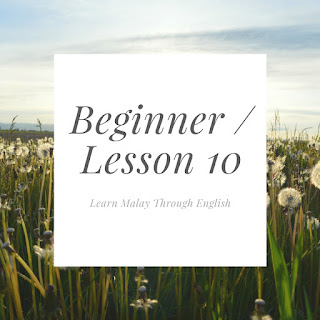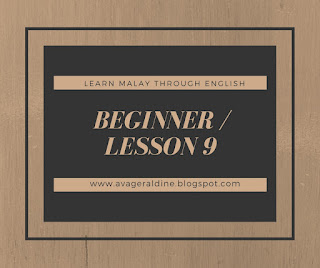Beginner / Lesson 13 (Possessive Pronouns, Possessive Adjectives, Demonstrative Adjectives) || Learn Malay Through English ||
Hello everyone! Welcome back to another lesson on the Malay language. :)
If you have missed my previous lesson of the "Beginner Level", click below:
Lesson 12 (Colours)
Click below to access the list of lessons available in the "Beginner Level" :)
Beginner || Learn Malay Through English ||
---------------------------------------------------------------------------------------------------------------
In this blog post, I will be entering "Possessive Pronouns" and "Possessive Adjectives" in the Malay language.
Looking at the identical words present in both quoted phrase, what is the meaning of "possessive"?
A quick check into the Oxford English Dictionary, the word "possessive" means "showing an unwillingness to share one's possession".
Based on my understanding, the word "possessive" is derived from the word "possession" which means "the state of having, owning or controlling something".
Coming back to the title, how is that related to our topics in this post?
In our daily life, how are we supposed to show our ownership towards something? This is where "Possessive Pronouns" and "Possessive Adjectives" come in.
---------------------------------------------------------------------------------------------------
A) Possessive Pronouns
What is possessive pronouns?
In the Malay language, the word "punya" is added after the pronouns which indicates ownership. The word "punya" derives from the word "kepunyaan".
Let's dwell into a few examples.
1. I did not have my umbrella. So, Jenny lent me hers.
- Saya tiada payung dengan saya. Jadi, Jenny pinjamkan dia punya kepada saya.
2. His car is faster than mine.
- Kereta dia lebih laju berbanding saya punya.
3. I know this drink is yours but I need to drink something.
- Saya tahu minuman ini adalah awak punya tetapi saya perlu minum sesuatu.
B) Possessive Adjectives
What is possessive adjectives?
If you have missed my previous lesson of the "Beginner Level", click below:
Lesson 12 (Colours)
Click below to access the list of lessons available in the "Beginner Level" :)
Beginner || Learn Malay Through English ||
---------------------------------------------------------------------------------------------------------------
In this blog post, I will be entering "Possessive Pronouns" and "Possessive Adjectives" in the Malay language.
Looking at the identical words present in both quoted phrase, what is the meaning of "possessive"?
A quick check into the Oxford English Dictionary, the word "possessive" means "showing an unwillingness to share one's possession".
Based on my understanding, the word "possessive" is derived from the word "possession" which means "the state of having, owning or controlling something".
Coming back to the title, how is that related to our topics in this post?
In our daily life, how are we supposed to show our ownership towards something? This is where "Possessive Pronouns" and "Possessive Adjectives" come in.
---------------------------------------------------------------------------------------------------
A) Possessive Pronouns
What is possessive pronouns?
- It means a pronoun indicating possession in its independent form. For example: mine, yours, hers, theirs.
- Mine - Saya punya / Aku punya
- Yours - Awak punya / Anda punya
- His / Hers - Dia punya / Beliau punya
- Ours - Kita punya / Kami punya
- Theirs - Mereka punya
In the Malay language, the word "punya" is added after the pronouns which indicates ownership. The word "punya" derives from the word "kepunyaan".
Let's dwell into a few examples.
1. I did not have my umbrella. So, Jenny lent me hers.
- Saya tiada payung dengan saya. Jadi, Jenny pinjamkan dia punya kepada saya.
2. His car is faster than mine.
- Kereta dia lebih laju berbanding saya punya.
3. I know this drink is yours but I need to drink something.
- Saya tahu minuman ini adalah awak punya tetapi saya perlu minum sesuatu.
B) Possessive Adjectives
What is possessive adjectives?
- It means a pronoun indicating possession in its dependent form. For example: my, your, her, their.
1. My ... . - ... saya.
- My name is Alexis. - Nama saya ialah Alexis.
2. Your ... . - ... awak.
- Are you going to bring your bag? - Adakah awak akan membawa beg awak?
3. His ... . - ... dia.
Hers ... . - ... dia.
- He dropped his notes. - Dia terjatuhkan nota-nota dia.
- She visited her mom yesterday. - Dia melawat ibu dia semalam.
4. Its ... . - ...-nya.
- Our cat is licking its paws. - Kucing kami sedang menjilat kakinya.
5. Our ... . - ... kami. / ... kita.
- We sold our car yesterday. - Kami telah menjual kereta kami semalam.
6. Their ... . - ... mereka.
- They thanked their parents. - Mereka mengucapkan terima kasih kepada ibu bapa mereka.
Note: In English, we put the possessive adjective before the noun.
For example: My family.
However in Malay, we put the possessive adjective after the noun.
- They thanked their parents. - Mereka mengucapkan terima kasih kepada ibu bapa mereka.
Note: In English, we put the possessive adjective before the noun.
For example: My family.
However in Malay, we put the possessive adjective after the noun.
For example: Keluarga saya.
C) Demonstrative Adjectives
What is demonstrative adjectives?
- This bottle. - Botol ini.
2. That - Itu
- That chair. - Kerusi itu.
3. These - Ini
- These bottles. - Botol-botol ini.
4. Those - Itu
- Those chairs. - Kerusi-kerusi itu.
Note: In English, the plural form of this is these and the plural form of that is those.
However in Malay, this and these have only one form which is ini while that and those is itu.
A way to differentiate between singular and plural is the noun.
In Malay, plural noun is repeated twice.
For example: Book - Buku
Books - Buku-buku
For more information on singular and plural noun,
Read more: Beginner / Lesson 7 || Learn Malay Through English ||
---------------------------------------------------------------------------------------------------------------
VOCABULARY
That is all for this lesson.
Over and out~ :)
C) Demonstrative Adjectives
What is demonstrative adjectives?
- It means to indicate how close / far away people / objects are from us. For example: this, that, these and those.
- This bottle. - Botol ini.
2. That - Itu
- That chair. - Kerusi itu.
3. These - Ini
- These bottles. - Botol-botol ini.
4. Those - Itu
- Those chairs. - Kerusi-kerusi itu.
Note: In English, the plural form of this is these and the plural form of that is those.
However in Malay, this and these have only one form which is ini while that and those is itu.
A way to differentiate between singular and plural is the noun.
In Malay, plural noun is repeated twice.
For example: Book - Buku
Books - Buku-buku
For more information on singular and plural noun,
Read more: Beginner / Lesson 7 || Learn Malay Through English ||
---------------------------------------------------------------------------------------------------------------
VOCABULARY
- Umbrella - Payung
- Borrow / Lend - Pinjam
- Car - Kereta
- Fast - Laju
- Faster - Lebih laju
- Drink (verb) - Minum
- Drinks (beverages) - Minuman
- Notes - Nota-nota
- Family - Keluarga
- Bottle - Botol
- Cat - Kucing
- Visit - Melawat
That is all for this lesson.
Click below to go the next lesson :)
See you soon!Over and out~ :)





Comments
Post a Comment